‘A picture is worth a 1000 words.’
I hope that my images convey a lot about the landscapes I photograph. They also say something about me as a photographer, but not in as much detail as a video or podcast could do.
So, because I can’t see myself dabbling in YouTube any time soon, I thought I would write a little about myself and what inspired me on my photographic journey.
Question 1. What was your career path? How did you get from being an aspiring photographer to actually doing it full time, for a living?
I think all photographers will have a different route into the business, although the thing that I am sure we all have in common is our love of being out with the camera.
I haven’t always been a photographer but I have had a camera for as long as I can remember. I began my working life as a draughts person (in the days of pen and ink) working on civil engineering projects – a creative occupation of sorts.
I moved to Suffolk in 2007 and at that time photography was just a hobby. I had enrolled on an Open College of Arts Photography course and was happy getting out with my camera whilst exploring other ways to make a living.
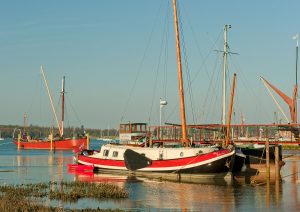 In 2008 I bought a 100 year old Dutch sailing barge and spent 2 years renovating her so that I could rent her out as luxury holiday accommodation on the Suffolk Coast. Ironically it was this venture that kick started my photography career.
In 2008 I bought a 100 year old Dutch sailing barge and spent 2 years renovating her so that I could rent her out as luxury holiday accommodation on the Suffolk Coast. Ironically it was this venture that kick started my photography career.
You often find in life that a new project opens doors that you had never perviously considered. I needed marketing images for my holiday business so I took them myself. I went out and explored all the coastal landscapes with my camera and took images that I thought would sell my holidays. I also got involved with the local sailing scene and began working at sailing clubs and sailing schools photographing members and students learning to sail. I photographed regattas and children’s sailing lessons in the school holidays, and larger sailing events on the east coast throughout the summer. I met a lot of useful contacts including magazine editors and a freelance journalist who I went on to work with on a regular basis.
By this time I was thinking about photography as a job but was struggling to get my images published. Eventually I began to realise that I stood a much better chance of selling my images if I could also write some words to go with them. A complete article is always a much more attractive proposition to an editor than a collection of images. So I set about finding something to write about and found the subject for my first article in the news, which at the time was full of the proposed sell off of the nations forests. 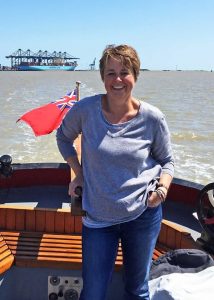
I wrote local articles about things I cared about and followed my forest article with others on Shingle Street, the river Deben, landscapes of Suffolk and other stories with an environmental slant. I also wrote ‘how to’ articles for photography magazines and then published my own annual sailing and watersports magazine for the East Coast.
I am a firm believer that if you want to do something then you should just go out and do it. Make your own luck and things will happen. If you want to be a photographer then go out and take photos.
I have always tried to apply this philosophy to my own work and like to think that I have made my own luck along the way. I learnt how to use publishing software and now design my own range of cards, calendars and have self published 3 photography books and 2 local guide books.
In 2016 I sold my barge and began teaching photography workshops.
Being a landscape photographer is not an easy profession, it takes a lot of hard work but the rewards are huge and I would definitely recommend it to anyone who has a passion for photography and the outdoors.
Question 2. How important is it for a landscape photographer to love the landscape, not just be driven by the need to get good images?
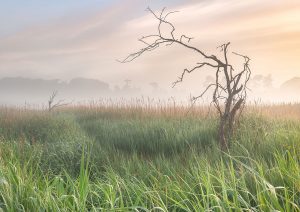 I believe that to be a good landscape photographer you have to care passionately about the landscapes you work in. To make good images you need a good connection with your subject.
I believe that to be a good landscape photographer you have to care passionately about the landscapes you work in. To make good images you need a good connection with your subject.
We can all visit iconic honeypot locations and make technically good images but I believe if you haven’t established a connection with that landscape then your images run the risk of being soulless copies of what has gone before. That might sound a bit harsh but if you get to know a landscape and build a connection with it you will find it much easier to take a photograph that says something different.
I think that is also the reason that I am not kit driven. You can make a better photograph with old equipment and a good connection with the landscape than you can with a brand new camera and no knowledge of the landscape you are photographing. With knowledge you connect and with a connection you see more and in my opinion these are the things that enable the photographer to make good images – not a camera bag full of expensive kit. I guess that’s also the reason I don’t endorse any commercial products!
Question 3. Which of your images best represent you as a photographer and why.
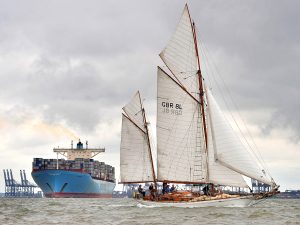 Power and Sail. I have a particular affection for this image which I feel typifies my early photography. The image was taken whilst I was covering the Classic Regatta, an annual event starting on the River Orwell. It was a case of being in the right place at the right time, which was onboard a RIB in the middle of a fairly choppy river. Whilst photographing the sailing yachts I noticed a container ship leave its berth and I just happened to be in exactly the right place to capture two very different faces of marine activity on the Orwell. This shot also earned me a ‘Highly Commended’ in the Shipwrecked Mariners Society annual photography competition in 2017.
Power and Sail. I have a particular affection for this image which I feel typifies my early photography. The image was taken whilst I was covering the Classic Regatta, an annual event starting on the River Orwell. It was a case of being in the right place at the right time, which was onboard a RIB in the middle of a fairly choppy river. Whilst photographing the sailing yachts I noticed a container ship leave its berth and I just happened to be in exactly the right place to capture two very different faces of marine activity on the Orwell. This shot also earned me a ‘Highly Commended’ in the Shipwrecked Mariners Society annual photography competition in 2017.
Midwinters morn. This tranquil image was taken during one of the most turbulent periods of my life – a time when nothing was certain, everything was a struggle and daily life seemed overwhelming. Through all the upheaval photography provided me with my happy times and this image is a beautiful reminder of this. It shows the church at Ramsholt taken one winter when I used to live in a draughty house overlooking the river there. The shot went on to be shortlisted in LPOTY sometime around 2012, but I can’t remember the exact year! At the time I thought it was a failure to be shortlisted but not to go any further – I now realise my mistake and wish I hadn’t been so hard on myself.
This tranquil image was taken during one of the most turbulent periods of my life – a time when nothing was certain, everything was a struggle and daily life seemed overwhelming. Through all the upheaval photography provided me with my happy times and this image is a beautiful reminder of this. It shows the church at Ramsholt taken one winter when I used to live in a draughty house overlooking the river there. The shot went on to be shortlisted in LPOTY sometime around 2012, but I can’t remember the exact year! At the time I thought it was a failure to be shortlisted but not to go any further – I now realise my mistake and wish I hadn’t been so hard on myself.
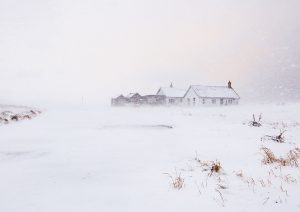 Blizzard This image was taken during one of my most memorable photography shoots when the ‘Beast from the East’ rolled in from the North Sea in 2018. I had walked to Shingle Street from my home in Hollesley, there was a weak winter sun in the sky and the landscape looked amazing under a blanket of snow. As soon as I arrived the wind picked up and the snow blew in, falling so hard that I couldn’t see the coastguard cottages or the little bungalow on the beach from the concrete drive. There was no shelter, it was difficult to compose an image let along hold the camera still enough to take one. Somehow despite the turbulence this image has a tranquility about it which I find really beautiful.
Blizzard This image was taken during one of my most memorable photography shoots when the ‘Beast from the East’ rolled in from the North Sea in 2018. I had walked to Shingle Street from my home in Hollesley, there was a weak winter sun in the sky and the landscape looked amazing under a blanket of snow. As soon as I arrived the wind picked up and the snow blew in, falling so hard that I couldn’t see the coastguard cottages or the little bungalow on the beach from the concrete drive. There was no shelter, it was difficult to compose an image let along hold the camera still enough to take one. Somehow despite the turbulence this image has a tranquility about it which I find really beautiful.
2018 was also the year that I lost my Dad, very suddenly and unexpectedly. He was the man who fostered my love of the natural world and taught me a respect and appreciation of the landscape and its wildlife. Without his enthusiasm and encouragement I don’t think I would be the photographer I am today.
Staverton Bluebells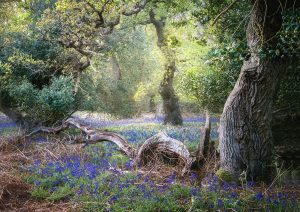 My final shot is an image taken at Staverton, a location which has become an important part of my photographic life and which formed the subject of my second photo book. It is an area of ancient oak woodland mixed with some of the tallest holly trees in Britain. The woods have a really magical quality to them and a visit with my camera always feels refreshing and restorative.
My final shot is an image taken at Staverton, a location which has become an important part of my photographic life and which formed the subject of my second photo book. It is an area of ancient oak woodland mixed with some of the tallest holly trees in Britain. The woods have a really magical quality to them and a visit with my camera always feels refreshing and restorative.
I guess this shot is indicative of where I see my photography going. I love exploring the natural world, and much prefer photographing wild elements to man made ones.
Question 4. How would you describe yourself in one sentence?
Photographer, author, wilderness seeker, wildlife lover, wannabe adventurer and dreamer!